Landmark status and tax incentives have been approved for the mixed-use redevelopment of 111 West Monroe Street in The Loop. Located at the corner of South Clark Street near Chase Tower, the two-building complex is the latest to receive such status as part of the broader LaSalle Street Reimagined initiative.
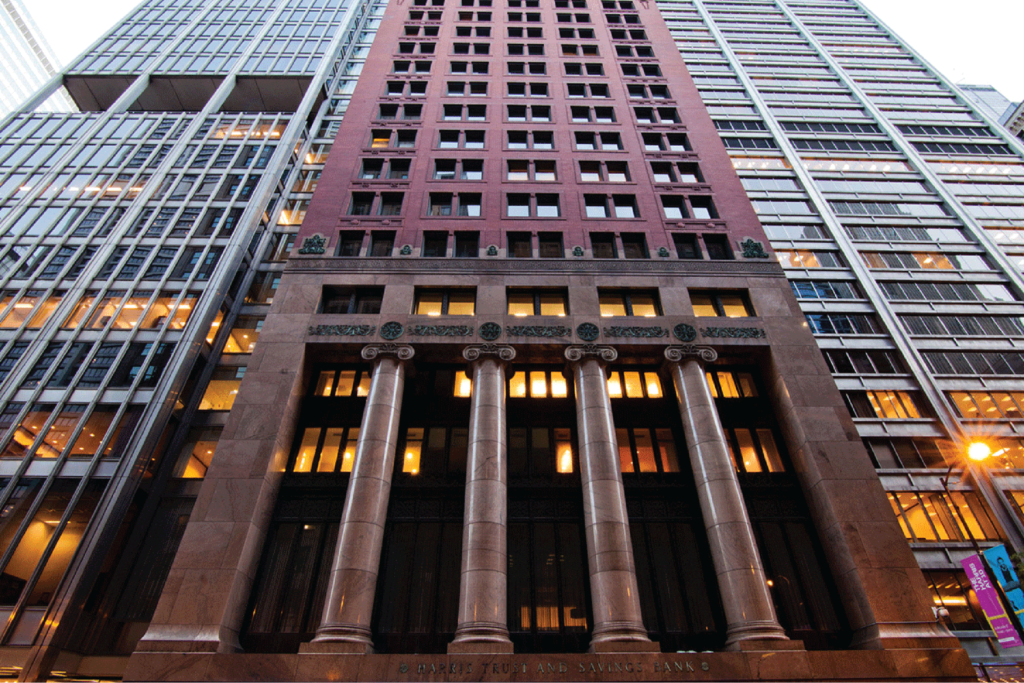
Image of 111 W Monroe Street via Hines
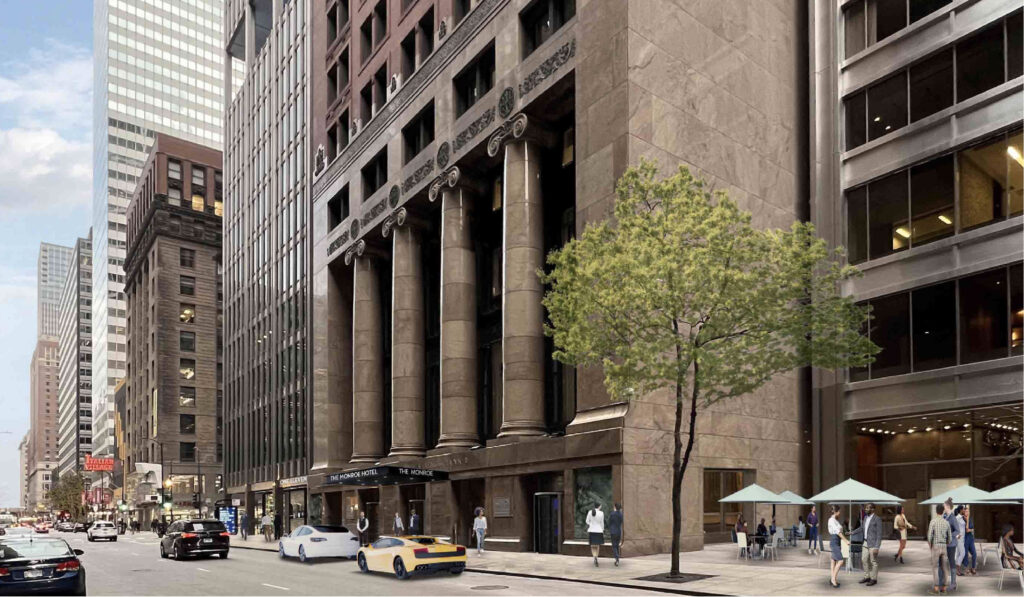
Rendering of 111 W Monroe Street by Stantec
The former Harris Bank complex consists of the original 1911 brick-clad structure, which received landmark designation, and an adjacent 1958 metal-clad expansion. Both buildings rise 24 stories in height. Together, they are being redeveloped by Capri Investment Group and The Prime Group, with Stantec leading the design.
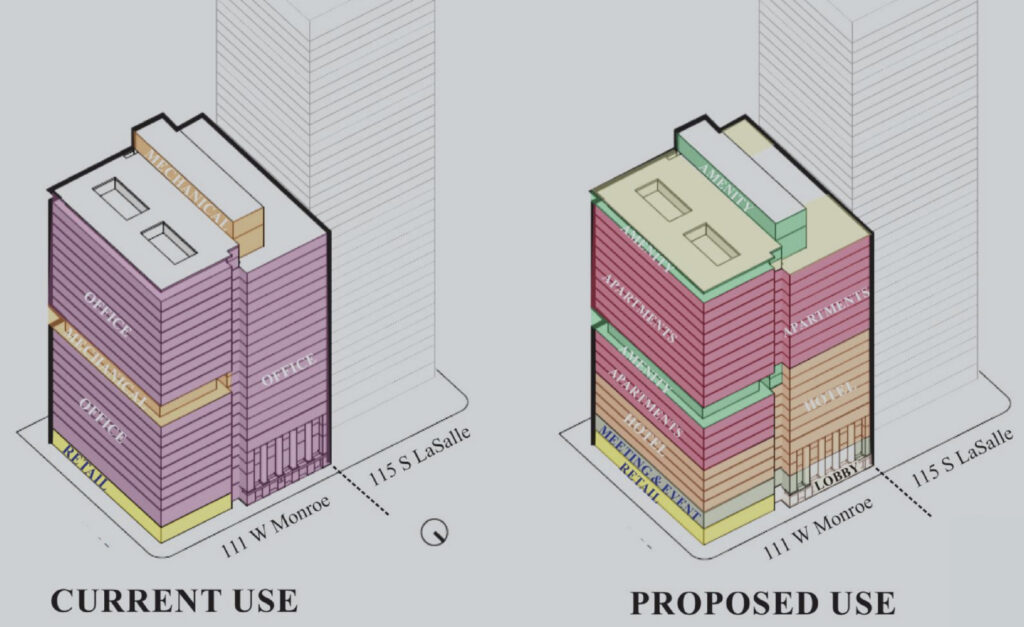
Proposed program of 111 W Monroe Street by Stantec
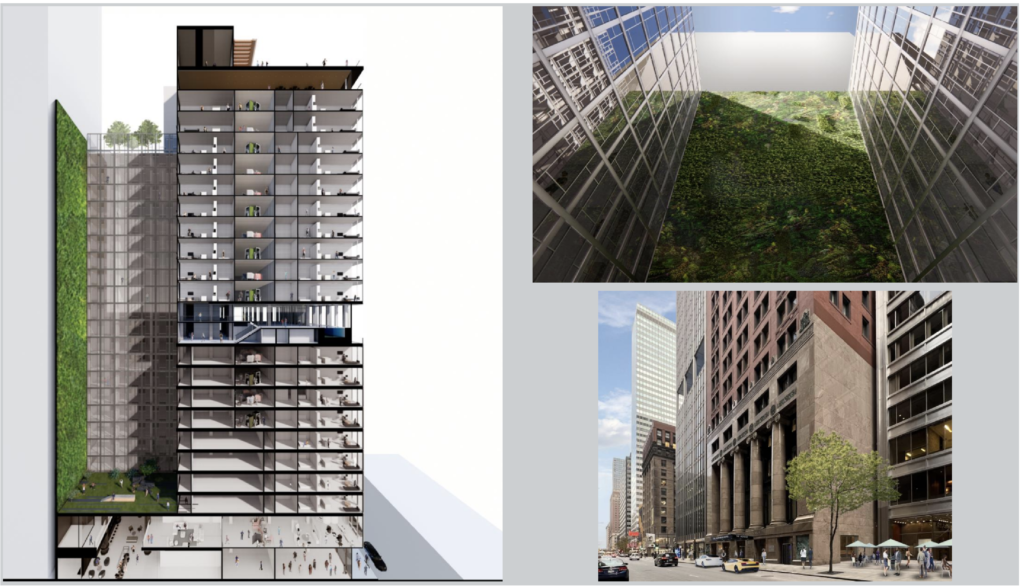
Renderings of 111 W Monroe Street by Stantec
The newly landmarked 1911 building will undergo façade repairs, gain a new side courtyard carved from the structure, and house the hotel’s ground-floor lobby and restaurant. The adjacent expansion will retain its corner retail space while converting the former office lobby into residential use. A car elevator will serve a 130-space underground garage.

Ground (left) – 2nd (center) – 12th (right) floor plans of 111 W Monroe by Stantec
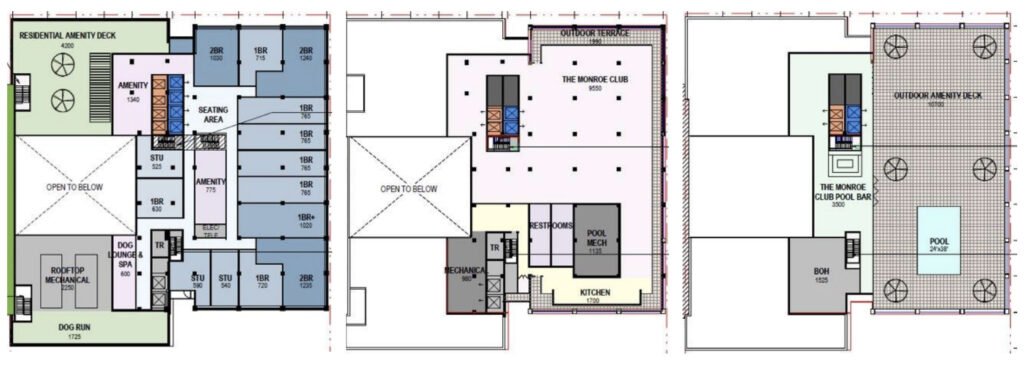
22nd (left) – 23rd (center) – 24th (right) floor plans of 111 W Monroe by Stantec
The second floor will be transformed into a large event center featuring 16,000 square feet of ballroom space. The 226-room hotel will occupy most of the lower levels of both buildings, with amenity areas on the 11th and 12th floors, including a spa, fitness center, golf simulators, and an indoor pool.
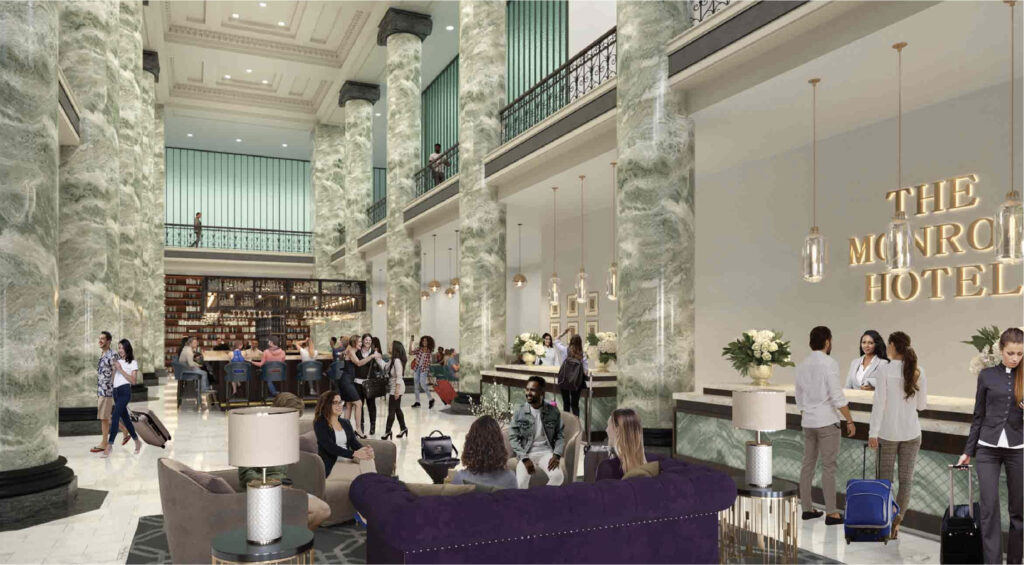
Rendering of 111 W Monroe Street by Stantec
Above these floors will be 345 residential units, comprising studio, one-bedroom, and two-bedroom layouts. Of these, 30 percent, approximately 104 units, will be designated as affordable housing under the city’s initiative. Residents will have access to shared amenities and a rooftop deck on the 22nd floor.
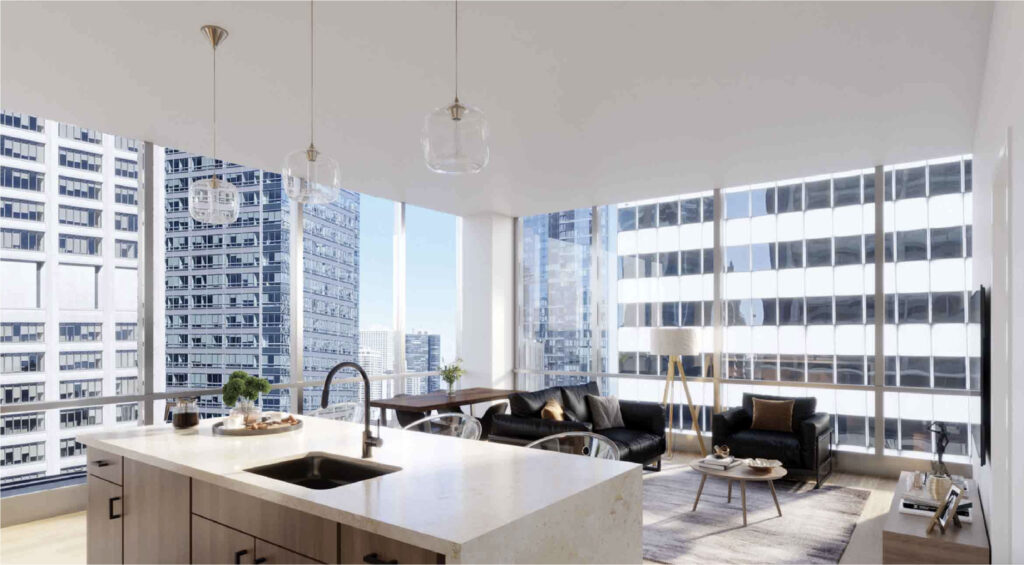
Rendering of unit within 111 W Monroe Street by Stantec
Both residents and visitors can also enjoy the reopened Monroe Club on the top two floors, which will operate as a restaurant with a rooftop pool deck and bar. The overall project is expected to cost $286.7 million, with $107.5 million allocated to the hotel and $179.2 million to the residential portion.
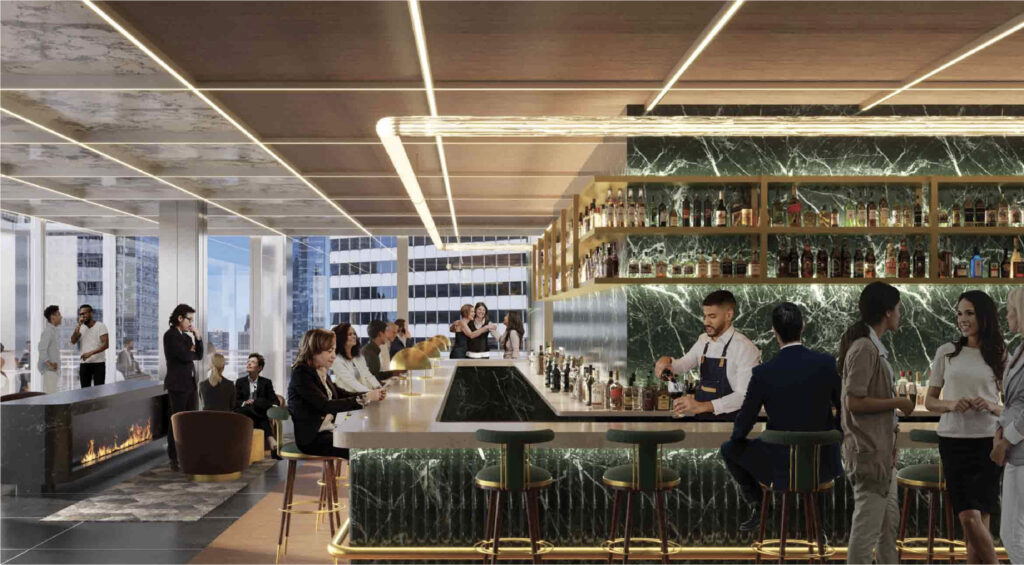
Rendering of 111 W Monroe Street by Stantec
The hotel will benefit from $19.4 million in property tax incentives over 12 years, while the residential component will use $40 million in TIF funds from the city initiative. Additional funding sources, including Low-Income Housing Tax Credits and Historic Tax Credits, will also be utilized. Construction is scheduled to begin later this year and conclude in the first half of 2027.
Subscribe to YIMBY’s daily e-mail
Follow YIMBYgram for real-time photo updates
Like YIMBY on Facebook
Follow YIMBY’s Twitter for the latest in YIMBYnews

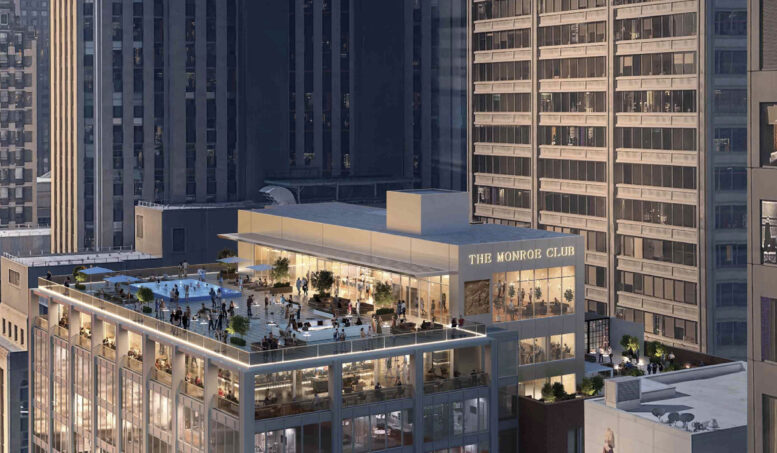
Love this. Too bad about the affordable element. I worry about crime rising in the Loop
Not sure if I’m worried about crime. But I predict the landlords and residents are going to face a population of incredibly entitled lower income residents who will prove to be very difficult and highly permanent tenants. Will they drag down the reputation and rental desirability of the regular priced apartments? Remains to be seen.
Meanwhile, the good people of Chicago have had their tax dollars wasted at an incredible level: each of the “affordable” units in the LaSalle corridor project is costing the city $600,000 in subsidies for units averaging one bedroom the developers will still own. This, at a time when empty lots are getting new modular 3 bedroom townhouses for $385,000, and fancy new luxury towers are building units for $450,000 each.
The city’s affordable housing efforts are a scam.
There are many well-researched articles available online that explain the many reasons why affordable housing is more expensive to build than market-rate projects. It’s a complicated nationwide issue, not a local scam.
Ditto every single word.
We need to be louder about this issue and raise awareness among Chicagoans.
That is correct Johnson must go
Damn, Tupper
Very excited about this one!!
Mixing affordable and market-rate housing has been ongoing in other US cities for decades. Boston, an example, has a lower crime rate than Chicago. For those concerned about crime, the same argument applies to all-affordable housing, which they would also say attracts crime and has higher costs compared to market-rate housing, so they would oppose those projects also. Do they want people with lower incomes to be pushed to “low cost” impoverished neighborhoods on the periphery with limited access to public transit, jobs, and amenities? Cities thrive with mixed-income neighborhoods that offer options for everyone. Income segregated neighborhoods perpetuate income inequality, which economists say harms the economy and the country. This project is a step towards creating a truly residential neighborhood for all.
Indeed, mixed-income projects have been shown to have better outcomes than segregation.
It’s telling that when we finally start to reintroduce housing diversity into the Loop—an area hollowed out by decades of disinvestment and flight to the suburbs—the immediate reaction is fear of “entitled lower income residents” and crime. Let’s be honest: the wealth abandoned these blocks when it was no longer fashionable to live downtown. Now that demand is creeping back, we want to pretend working-class people don’t deserve access to transit, jobs, and the very public infrastructure their tax dollars have also supported.
The Loop shouldn’t be reserved only for the privileged few who can afford a $3,000 one-bedroom. Affordable housing here is about undoing decades of exclusionary practices that created segregated neighborhoods and forced working families into under-resourced areas far from opportunity.
Yes, the subsidy math is flawed—no argument there. Rent-to-own programs and equity-building models should have been front and center to ensure residents gain long-term stability rather than enriching landlords. But the answer isn’t to abandon affordability in these locations. The answer is to hold developers and the city accountable for delivering inclusive housing without using cost as a smokescreen for keeping low- and moderate-income people out of vibrant, transit-rich neighborhoods.
If Chicago really wants to call itself a progressive city, it can’t just build luxury towers and declare success while the people who make this city run are pushed further and further out.
I think the problem is that most reasonable people don’t want a progressive city due to the failures of the progressive movement making “progressive” cities far more regressive than the average. The average low-income New Yorker is far better off than the average low-income Seattle or San Francisco resident, by a marathon vs. a mile. Brandon Johnson types do far more damage to the city than development focused types that tend to frown upon near-seven figure/ unit affordable housing grifts.
I don’t think comparing San Fran/Seattle to Chicago/NY is a sound comparison. San Fran and Seattle are dealing with massive wealth differences due to high concentration of tech. Chicago/NY have a much more diverse employment as well as diverse set of incomes. While San Fran & Seattle are super progressive, ignoring the tech bubble discredits yor argument.
Bingo
Wow, some of you are horrible human beings.
Gotta love the doubling down on the pro-segregation…
Yep…
I reject pretty much 100% of the arguments being made by the people who want to create mixed-income, affordable housing by design. People like you are the problem. You are full of bad ideas and false assumptions.
Nobody owes anybody of any income subsidized housing. If you can’t afford to live in the Loop, then you can’t afford to live in the Loop. This city has plenty of places where you can afford to live. All housing should be free market.
We wouldn’t have mixed income housing “by design” if we didn’t have segregated income neighborhoods “by design.” In an ideal world, ALL neighborhoods would accommodate a diverse mix of incomes and they would be market rate. We’ve designed neighborhoods to be income segregated (and race segregated also, btw) with decades of zoning policy that has forced market rate housing to be a certain size, parking minimums, building types, financing, etc that have created these income segregated enclaves that foster the types of classist comments that we’re seeing here. People seeing housing as a speculative investment instead of a human right doesn’t help either.
Someone making a low wage working a full time or multiple part time jobs should not have to commute hours to get to their jobs because we’ve designed our city to make it harder for them at all levels.
I’d be all for everything as market rate if we had system that allowed for people to live near their workplace. Not everyone needs to live in a new high amenity building, but we’ve built the loop to be a zoned as a central business district, so a little bit of a hand on the scales necessitates it in this case.
You have obviously been indoctrinated into a lot of bad ideas, so there is no point even trying. But I agree with nearly everything you stated. Your “solutions” to your purported problems never work, in fact they have a history of always making them worse, and yet you will double down on them more. Been there, done that, seen your type over and over.
Very very ironic that you claim everyone who opposes you is “indoctrinated” while you completely ignore that your fantasy-land ideas are literally the exact 1950s-era policies which gave us vertical urban slums. Please be less of a nuisance on this site or I would not be surprised if your rage-baiting comments are deleted for not contributing to positive discussion.